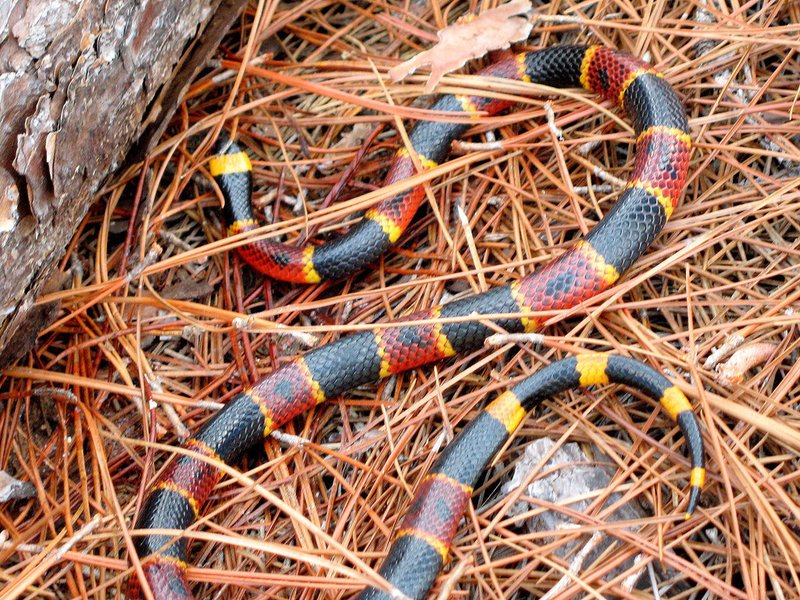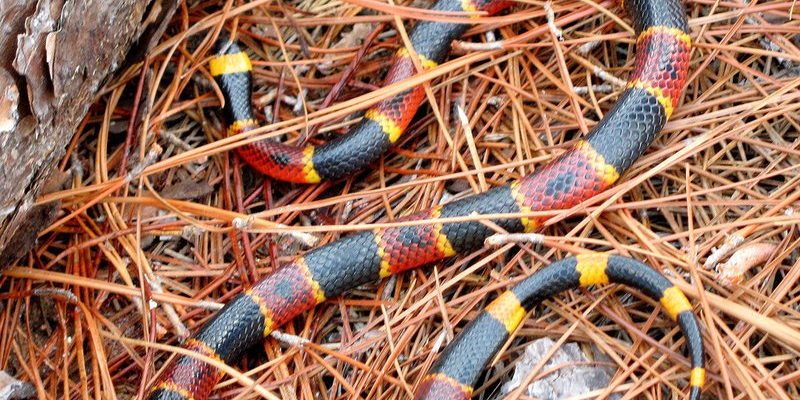
Have you ever heard of the Eastern Coral Snake? This stunning creature may be one of the most beautiful and feared snakes in North America. With its striking colors and unique patterns, it’s hard not to be mesmerized. But don’t let its beauty fool you! The Eastern Coral Snake is venomous, and understanding more about it can help you appreciate this remarkable reptile while keeping a safe distance.
Imagine a snake that’s not just an inhabitant of the wild, but a living piece of art slithering through the underbrush. The bright red, yellow, and black bands create a pattern similar to a child’s drawing of a snake—bold and colorful. And just like a sunset, its colors tell a story: one of warning and survival. As we explore this fascinating creature, you’ll learn about its behavior, habitat, diet, and even what makes it tick.
Physical Characteristics
The Eastern Coral Snake is easily recognizable due to its vibrant color scheme. This snake can grow to about 2 to 3 feet long but can sometimes reach up to 4 feet. Its body is slender and elongated, perfect for navigating through its environment. The distinct coloration is a unique feature, with bright red and yellow bands outlined by black. This specific pattern is crucial for identification, especially because it mimics other non-venomous snakes, which serve as a warning to potential predators.
These snakes are not just pretty faces, though. Their smooth scales reflect light, giving them a polished look. You might be surprised to learn that their scales play an essential role in their ability to move quickly through grass and leaf litter. This means that the Eastern Coral Snake can escape threats or hunt for food using its cunning and speed.
Essentially, their coloration is a prime example of aposematic signaling, meaning it’s a warning coloration intended to deter potential predators. So, if you ever spot one, give it the respect it deserves, as the brilliant hues are nature’s way of saying, “Look, but don’t touch!”
Habitat and Distribution
The Eastern Coral Snake is primarily found in the southeastern United States, thriving in diverse habitats. You can encounter them in Florida, Georgia, the Carolinas, and parts of Alabama and Mississippi. These snakes prefer environments like woodlands, scrublands, and marshes, where they can find both cover and their preferred prey.
One of the beautiful aspects of their habitat is the lush undergrowth that provides both hiding spots and hunting grounds. This snake is often found in areas with abundant leaf litter, where it blends seamlessly with its surroundings. In this way, it is a master of camouflage, using the forest floor as both a hunting ground and a refuge.
Interestingly, the Eastern Coral Snake is not usually found far from water, preferring areas close to streams or marshes. These locations provide not only hydration but also a plethora of food options, such as lizards and small snakes. Understanding their habitat can give you insights into where to look for them and how they interact with their ecosystem.
Behavior and Diet
The Eastern Coral Snake is known for its secretive behavior. Unlike many other snakes that bask in the sun, this snake is more reclusive and spends a lot of time hidden beneath leaves or in burrows. They are primarily active during the day but may also hunt at dusk when their prey is active. This adaptability is a key factor in their survival.
As for their diet, Eastern Coral Snakes are carnivorous. They primarily feed on other snakes, especially smaller ones, as well as lizards. This predatory behavior plays an essential role in controlling the population of their prey species. They have a unique method of hunting—using their sense of smell to track down their victims. Once they find a target, they strike quickly, using their potent venom to subdue it.
The venom of the Eastern Coral Snake is a neurotoxin, which affects the nervous system and can cause paralysis in its prey. Luckily for humans, bites are rare because of their shy nature and the fact that they tend to avoid confrontation. However, if bitten, immediate medical attention is crucial, as their venom can be deadly if not treated.
Reproduction and Lifespan
Eastern Coral Snakes reach maturity at about two years old, and their reproductive cycle is quite interesting. They are oviparous, meaning they lay eggs rather than giving birth to live young. Females typically lay around 3 to 12 eggs in a concealed location, such as under leaf litter or logs. These eggs are usually laid in the spring, and they incubate for about two to three months before hatching.
The hatchlings are miniature versions of the adults, measuring about 10 to 12 inches long. They are born with the same vibrant coloration, which serves as a warning to potential predators. Interestingly, young snakes face numerous challenges, from predators to environmental factors, but if they survive, they can live for 7 to 10 years in the wild.
In captivity, with optimal care, Eastern Coral Snakes can live even longer, sometimes reaching over 15 years. This longevity highlights the importance of understanding their specific needs if kept in a controlled environment. Such knowledge not only increases their lifespan but also enhances the experience for any snake enthusiast.
Importance in Ecosystems
The Eastern Coral Snake plays a significant role in its ecosystem. As a predator, it helps maintain the balance by controlling the populations of smaller reptiles. This dynamic is essential for fostering biodiversity, ensuring that no single species dominates the environment.
Moreover, by being at the top of the food chain in its specific niche, the Eastern Coral Snake contributes to the overall health of its habitat. Their presence indicates a stable ecosystem, as they rely on various prey species for their survival. When these snakes thrive, it often suggests that the environment is well-maintained and balanced.
Furthermore, the Eastern Coral Snake’s venom holds potential for research in medicine, particularly for understanding neurotoxins and their effects on the human body. Scientists study these venoms to develop new treatments for various medical conditions, demonstrating that even the most feared creatures can contribute positively to our understanding of health and science.
Conservation Status
Currently, the Eastern Coral Snake is not considered endangered, but they face challenges from habitat destruction and human encroachment. The development of land for agriculture and urbanization reduces their natural habitats, making it harder for these snakes to find shelter and food.
Public perception also plays a crucial role in their survival. Many people fear snakes, often leading to unnecessary killings when they are spotted. Education about the Eastern Coral Snake and its role in the ecosystem is essential for promoting coexistence between humans and wildlife. Understanding that this creature is not an aggressive threat can foster a more balanced perspective.
Conservation efforts are vital in ensuring their habitat remains intact, and organizations are working to raise awareness about the importance of preserving these remarkable snakes. Supporting wildlife conservation programs can help maintain the delicate balance of their ecosystems and ensure that future generations can appreciate the beauty of the Eastern Coral Snake.
FAQ
What does an Eastern Coral Snake look like?
The Eastern Coral Snake has a distinctive appearance, featuring bright red, yellow, and black bands. The pattern is often used to distinguish it from non-venomous snakes, as these colors are a warning signal to potential predators. Adults typically range from 2 to 3 feet in length.
Is the Eastern Coral Snake aggressive?
Generally, the Eastern Coral Snake is not aggressive. It prefers to avoid confrontation and is often shy around humans. If threatened, it may retreat rather than strike, but like any wild animal, it can bite if cornered. It’s essential to respect their space and not provoke them.
How dangerous is the venom of the Eastern Coral Snake?
The venom of the Eastern Coral Snake is highly toxic and can cause severe neurological effects, which means it can lead to paralysis. However, bites are infrequent, and with prompt medical attention, fatalities are rare. It’s essential to seek emergency care if bitten.
What do Eastern Coral Snakes eat?
Eastern Coral Snakes primarily eat other snakes, particularly smaller species, as well as lizards. Their diet plays a crucial role in controlling the populations of these reptiles, making them an integral part of their ecosystem.
Where can you find Eastern Coral Snakes?
You can find Eastern Coral Snakes in the southeastern United States, particularly in regions with lots of underbrush and near water sources. They thrive in woodlands, scrublands, and marshes, where they can easily hunt and hide.
How can you tell an Eastern Coral Snake from a non-venomous mimic?
The key to identifying the Eastern Coral Snake versus a non-venomous mimic lies in its color pattern. Remember the rhyme: “Red on black, friend of Jack; red on yellow, kill a fellow.” If the red bands touch the yellow bands, it’s likely a venomous coral snake. If they touch black, it’s a harmless species.
What is the lifespan of an Eastern Coral Snake?
In the wild, Eastern Coral Snakes typically live for 7 to 10 years, but in captivity, they can live longer—sometimes over 15 years—with proper care. The controlled environment offers them better protection and minimizes threats from predators.
Are Eastern Coral Snakes common?
While Eastern Coral Snakes are present in the southeastern U.S., they aren’t commonly seen due to their secretive nature. They tend to stay hidden in leaf litter and are more active during the day to hunt, making encounters with humans relatively rare.
Can Eastern Coral Snakes survive in captivity?
Yes, Eastern Coral Snakes can survive in captivity when provided with the right environment, diet, and care. They require specific conditions, such as humidity and temperature control, to thrive. However, they are not commonly kept as pets due to their specialized needs and potential danger.
How can I help protect Eastern Coral Snakes?
To help protect Eastern Coral Snakes, consider supporting wildlife conservation efforts focused on preserving their habitats. Spreading awareness about their ecological importance and promoting coexistence can also make a significant difference. Educating others about these snakes can reduce fear and promote understanding.

